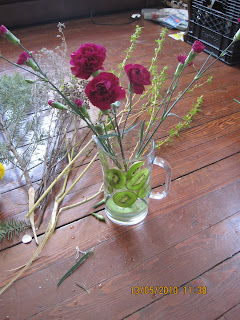While this mental image may be true of some carnival game operators, most simply find a niche and fill it. Nicole saw this gap in the market and now owns 9 blow up jumping units which she rents out to carnivals and private parties. I have deliberately steered away from the word 'castle' as in today's time of DS's, robotic playmates and online zoo animals, the humble castle just doesn't cut it. While the castle still sits in the nostalgic corner with the Rubik's cube and the yo yo, the jumping units of today include the red rocket, the elephant slide, the club house and the big draw cards, the jumping tractor and the dump truck slide.
My day as a carny began as I arrived at the community oval for the relay for life fair. The pitch and put lady was just laying out her holes while the face painter was placing mini chairs in a row by the coloured tubes that would ensure the oval was soon filled with tigers, butterflies and kitty cats.
The dump truck slide is definitely an impressive example of inflatable technology. It has several zippers to allow for easier deflation -unfortunately these zippers can also wreak havoc with inflation, especially if the one at the top hasn’t been zipped up and the top of your dump truck appears somewhat floppy. This then means that a carny must use a rope to pull one side of the blow up truck down while the other carny bravely climbs up through the plastic dump truck wheels to zip up the pesky zipper.... not an easy task!
Once all inflatables are firmly zippered and inflated, its time to set up the crowd guide ropes, put down the tarps for the shoe free zone and place the appropriate mats in the landing zone.
 Once you have done all of this and the kids arrive you realise there was absolutely no point in doing any of it. Whether it's a developmental thing like tying your shoelaces or mastering buttons, little kids just don't see bright orange tape stretched out between stakes in a fence like construction. Well that's not true, they see it as a small inconvenience to be jumped on the way to the next unit... or a small stretchy tie that will be busted through with a little bit of perseverance. They also have no concept of shoes off when they see pumped up plastic up ahead, just that they must make their little legs move as fast as possible until their face is planted in plastic heaven. And lastly you discover that kids are like a magnate in reverse when it comes to landing pads. They are lined up, heading straight for it and at the last minute, boom, off the side and onto the ground. Rounding a bunch of kids up into a jumping unit is also a little like trying to sweep up Styrofoam balls...
Once you have done all of this and the kids arrive you realise there was absolutely no point in doing any of it. Whether it's a developmental thing like tying your shoelaces or mastering buttons, little kids just don't see bright orange tape stretched out between stakes in a fence like construction. Well that's not true, they see it as a small inconvenience to be jumped on the way to the next unit... or a small stretchy tie that will be busted through with a little bit of perseverance. They also have no concept of shoes off when they see pumped up plastic up ahead, just that they must make their little legs move as fast as possible until their face is planted in plastic heaven. And lastly you discover that kids are like a magnate in reverse when it comes to landing pads. They are lined up, heading straight for it and at the last minute, boom, off the side and onto the ground. Rounding a bunch of kids up into a jumping unit is also a little like trying to sweep up Styrofoam balls...So after a day of repeating the words 'shoes off' more times than sting sung 'Roxanne' and seeing the bottom lip reactions to the phrase 'you're too big' and after having mastered the art of climbing an inflatable tractor and catching a bee in a paper coffee cup, it was finally time to cut the power. It's literally quite a deflating moment watching the units come down amongst metres of tattered orange tape and bent stakes... But just as you feel like maybe the sentiment of it all is getting too much, you realise that all these units have to be rolled and folded and fitted back into the bags they came in. You can almost see the carny type man at the material factory designing the perfect bag to fit the unit and then removing a metre of material for his own personal amusement!
So the pros of being a carny? Working outside is definitely a plus. Seeing the sheer joy on the kids faces is also an amazing way to spend a day and the people, colour and nostalgia of it makes it a really pleasant job.
The down side to it is the time it takes to set up and pack up and of course the patients it takes to explain to a five year old why they can't enter the red rocket with their spiky fairy wings and gumboots on...
share on:facebook
























